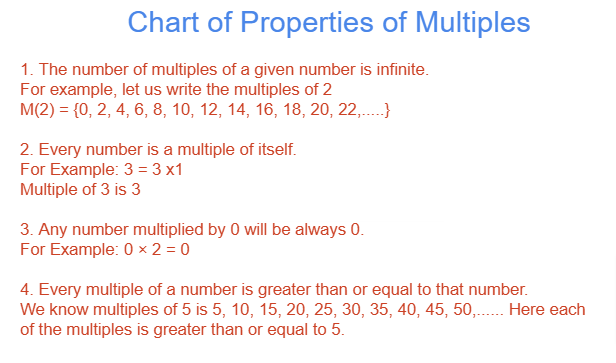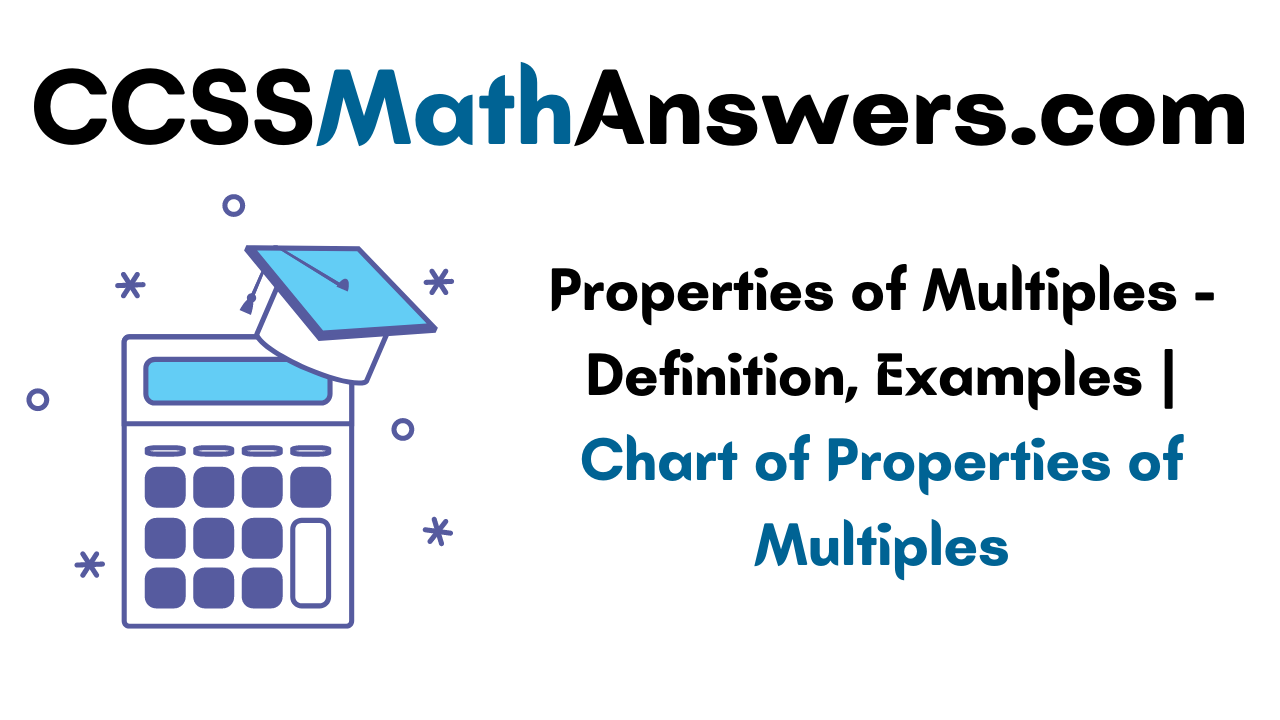Multiples are the basic level of maths which you have to learn to become a master. It is a product of two or more numbers. You can check the multiples of the given numbers with the exact divisor method. Know the definition, properties of multiples in this article. Know the difference between factors and multiples from here. Also, you can get a detailed explanation for all the problems related to multiples. All these concepts will help your child enhance their knowledge, resulting in the best score in the exams.
Do Refer:
Multiples – Definition
Multiples are defines are the products you get when you multiply two or more numbers. Multiples are nothing but tables of given numbers.
Example: Product of 2 and 5
2 × 5 = 10
Here 10 is multiple.
Thus the multiples of 2 and 5 are 10.
Chart of Properties of Multiples

Properties of Multiples
The properties of multiples are explained step by step in the below section.
Property 1.
1 is a factor of every number
Example:
1 × 42 = 42
1 × 524 = 524
1 × 9 = 9
We get the given number when we multiple 1 with any number.
Property 2.
Every number is a factor in itself.
Example:
464 = 1 × 464
24 = 1 × 24
We know that 1 is a factor, so that means we get the same result when we multiply with 1.
Therefore every number is a factor in itself.
Property 3.
Every factor of a number is an exact divisor of that number.
Example:
Factors of 10 are 1, 2, 5, 10.
Property 4.
Factors of a given number are finite.
Example: Factors of 8 are 1, 2, 4, 8 only.
Property 5.
Every factor of a number is less than or equal to the number.
Example:
Let us take the factors of 6 are 1, 2, 3 and 6.
2 × 3 = 6
Here 2 and 3 are less than 6.
1 × 6 = 6
Here 6 is equal to 6.
Therefore the above example satisfies the property “Every factor of a number is less than or equal to the number.”
Property 6.
The number of multiples of a given number is infinite.
For example, let us write the multiples of 2
M(2) = {0, 2, 4, 6, 8, 10, 12, 14, 16, 18, 20, 22,…..}
As we know that the numbers are infinite the multiples of 2 will be infinite.
Thus it shows that “The number of multiples of a given number is infinite.”
Property 7.
Every number is a multiple of itself.
Property 8.
Any number multiplied by 0 will be always 0.
Example:
For example, when we multiply 2 with 0 we get 0.
0 × 2 = 0
When we multiply 0 with 649 we get 0.
0 × 649 = 0
When we multiply 25 with 0 we get 0.
25 × 0 = 0
When we multiply 16 with 0 we get 0.
16 × 0 = 0
Property 9.
Every multiple of a number is greater than or equal to that number.
For example, we multiply 24 with 2
24 × 2 = 48
48 is greater than 24.
24 × 1 = 24
24 is equal to 24.
Thus it satisfies the property that “Every multiple of a number is greater than or equal to that number”
Difference Between Factors and Multiples
| Factors | Multiples |
| 1. Factors are defines as the exact divisors of a number. | 1. Multiples are defined as the product you get when you multiply two or more numbers. |
| 2. The operation used to find the factors of a number is division. | 2. The operation used to find the multiples is multiplication. |
| 3. The outcome of the factors should be less than or equal to the given number. | 3. The outcomes of the multiples should be greater than or equal to the given number. |
| 4. The number of factors is finite. | 4. The number of multiples is infinite. |
Examples of Properties of Multiples
Example 1.
Write 5 multiples of
i). 12 ii). 5 iii). 9 iv). 15 v). 3
Solution:
i. 12
12 × 1 = 12
12 × 2 = 24
12 × 3 = 36
12 × 4 = 48
12 × 5 = 60
ii. 5
5 × 1 = 5
5 × 2 = 10
5 × 3 = 15
5 × 4 = 20
5 × 5 = 25
iii. 9
9 × 1 = 9
9 × 2 = 18
9 × 3 = 27
9 × 4 = 36
9 × 5 = 45
iv. 15
15 × 1 = 15
15 × 2 = 30
15 × 3 = 45
15 × 4 = 60
15 × 5 = 75
v. 3
3 × 1 = 3
3 × 2 = 6
3 × 3 = 9
3 × 4 = 12
3 × 5 = 15
Example 2.
Write the properties of multiples of 3
Solution:
By using the properties we can know the multiples of 3, which indicates that by adding their figures the result can be 3, 6 or 9 is a multiple of 3.
M(3) = {0, 3, 6, 9, 12, 15, 18, 21, 24, 27, 30,…}
Number 30: 3 + 0 = 3, 3 is a multiple of itself.
Number 27: 2 + 7 = 9, 9 is a multiple of 3.
Number 24: 2 + 4 = 6, 6 is a multiple of 3.
Number 21: 2 + 1 = 3,3 is a multiple of 3.
Number 18: 1 + 8 = 9,9 is a multiple of 3.
Number 15: 1 + 5 = 6,3 is a multiple of 3.
Number 12: 1 + 2 = 3,3 is a multiple of 3.
Example 3.
Write the properties of multiples of 6.
Solution:
6 × 1 = 6
6 × 2 = 12
6 × 3 = 18
6 × 4 = 24
6 × 5 = 30
6 × 6 = 36
6 × 7 = 42
6 × 8 = 48
6 × 9 = 54
6 × 10 = 60
M(6) = {0,6, 12, 18, 24, 30, 36, 42, 48, 54, 60….}
Example 4.
Write the properties of multiples of 9.
Solution:
By using the properties we can know the multiples of 9, which indicates that by adding their figures the result can be 9 is a multiple of 9.
M(9) = {0, 9, 18, 27, 36, 45, 54,….}
Number 9: 9 + 0 = 9,9 is a multiple of 9.
Number 18: 1 + 8 = 9,9 is a multiple of 9.
Number 27: 2 + 7 = 9, 9 is a multiple of 9.
Number 36: 3 + 6 = 9, 9 is a multiple of 9.
Number 45: 4 + 5 = 9, 9 is a multiple of 9.
Example 5.
Write the 10 multiples of 5.
Solution:
5 × 1 = 5
5 × 2 = 10
5 × 3 = 15
5 × 4 = 20
5 × 5 = 25
5 × 6 = 30
5 × 7 = 35
5 × 8 = 40
5 × 9 = 45
5 × 10 = 50
Therefore M(5) = {5, 10, 15, 20, 25, 30, 35, 40, 45, 50}
FAQs on Properties of Multiples
1. Write 10 multiples of 3.
3 × 1 = 3
3 × 2 = 6
3 × 3 = 9
3 × 4 = 12
3 × 5 = 15
3 × 6 = 18
3 × 7 = 21
3 × 8 = 24
3 × 9 = 27
3 × 10 = 30
Thus M(3) = 3, 6, 9, 12, 15, 18, 21, 24, 27, 30
2. What is a multiple number?
The multiples of a number are the result of the multiplication of the number by another number, therefore, a number is a multiple of another if it contains an integer number of times.
Multiple of the number = main number × n
3. Write the common multiples for 2 and 3
The common multiples of 2 and 3 are 6, 12, 18, 24, 30, 36, 42. The multiples of 6 will be common multiples of 2 and 3.
